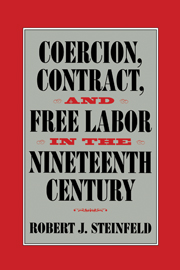Book contents
- Frontmatter
- Contents
- List of Illustrations and Tables
- Acknowledgments
- Introduction: Free Wage Labor in the History of the West
- PART ONE AMERICAN CONTRACT LABOR AND ENGLISH WAGE LABOR: THE USES OF PECUNIARY AND NONPECUNIARY PRESSURE
- PART TWO “FREE” AND “UNFREE” LABOR IN THE UNITED STATES
- 8 “Involuntary Servitude” in American Fundamental Law
- 9 Labor Contract Enforcement in the American North
- Conclusion
- Index
9 - Labor Contract Enforcement in the American North
Published online by Cambridge University Press: 06 July 2010
- Frontmatter
- Contents
- List of Illustrations and Tables
- Acknowledgments
- Introduction: Free Wage Labor in the History of the West
- PART ONE AMERICAN CONTRACT LABOR AND ENGLISH WAGE LABOR: THE USES OF PECUNIARY AND NONPECUNIARY PRESSURE
- PART TWO “FREE” AND “UNFREE” LABOR IN THE UNITED STATES
- 8 “Involuntary Servitude” in American Fundamental Law
- 9 Labor Contract Enforcement in the American North
- Conclusion
- Index
Summary
Binding wage labor contracts offered nineteenth-century English employers significant economic benefits, but contracting was only a useful strategy for reducing turnover and monitoring costs if employers were able to enforce contracts quickly and cheaply. But for this ability to enforce contracts simply and cheaply, employers would have had to pursue cost reduction in other ways, and the contract system would not have assumed the importance it did in English wage labor relations. In the northern United States, a summary criminal remedy to enforce labor contracts was not normally available against native-born white adult wage workers at any time during the nineteenth century. This very real constraint, however, did not eliminate the value to northern employers of using binding contracts with wage workers, largely because they had available a reasonable substitute for penal sanctions, wage forfeiture. Wage forfeiture made labor contract enforcement inexpensive and effective. Because wage forfeiture was available in the United States, contracting could play a role in nineteenth-century American wage labor relations not completely unlike the one it played in English wage labor relations. The American practice had the added virtue that it was less vulnerable to the charge that it turned contracts of service into contracts of slavery, even though it confronted wage workers, depending on the circumstances, with a very disagreeable alternative to continued performance.
ENTIRETY
In England, the system of penal sanctions had been established by Parliament. In the United States, state legislatures were not prepared in most cases to follow a similar course, perhaps because of the broadened suffrage legislators confronted.
- Type
- Chapter
- Information
- Coercion, Contract, and Free Labor in the Nineteenth Century , pp. 290 - 314Publisher: Cambridge University PressPrint publication year: 2001
- 1
- Cited by



